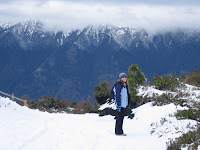 The open pit copper mine Chuquicamata.
The open pit copper mine Chuquicamata.June 30, 2007
Breakfast at Tatio
 We visited the Tatio geysers at the highest geothermal field in the world. We had to get up at 4 am to be there at sunrise when the temperature change causes the geysers to erupt. This isn't garbage in the geothermal pool--the tour guides are warming up milk for coffee and boiling eggs for our breakfast.
We visited the Tatio geysers at the highest geothermal field in the world. We had to get up at 4 am to be there at sunrise when the temperature change causes the geysers to erupt. This isn't garbage in the geothermal pool--the tour guides are warming up milk for coffee and boiling eggs for our breakfast.
The Inca Trail
On the Bus
Algae Harvest
In the Arms of Christ
Cochabamba
June 29, 2007
Getting to Know You
You'll notice I get more reflective as my journeys come to an end, but why am I on this tangent of different ways of knowing? Because Tuesday we saw Chuquicamata, the largest open pit mine in the world, a hole in the ground kilometers wide and almost a kilometer deep. This copper mine is owned and operated by the government of Chile. Near the mine is the company town of the same name that is essentially a ghost town. The government decided the town was too contaminated so they have moved the workers to Calama, a town about 15 km away. A good decision, but it leaves houses, an auditorium, a theater, schools, parks and playgrounds eerily empty. The hospital has already been covered by mountains of rock from the pit and houses are soon to follow. The town of Chuquicamata reminds me of the Ukrainian town of Prypiat near the Chernobyl nucelar plant. Prypiat was also abandoned due to contamination, but in a matter of hours instead of years.
There is a scene in The Motorcycle Diaries, a film about Che Guevara's travels with a friend through South America, where they are at Chuquicamata and a foreman tells them the mine is not a tourist site. I agree; however, I think the point of visiting places like Chuqui and Chernobyl isn't to pasear (another great Spanish word), but to conocer, to know somewhere or something or someone personally and to learn from them.
June 25, 2007
Pimp My Llama
June 23, 2007
The Second Longest Day
Only 3 hours after getting off the bus in San Pedro de Atacama, we were on another bus, a tourist bus, going to the Chilean Valle de la Luna (Moon Valley). This was definitely more impressive than the Bolivian version we visited near La Paz. The most impressive time to see the valley is sunset. We were there, but so were the clouds, so the effect was muted.
I have to explain about the buses because anyone who has ridden buses in the U.S. probably thinks we're crazy. There are different levels of service here depending on the length of the trip and how much you want to pay. The classic level, which we took to Valparaíso, is the basic level--clean, comfortable buses with a bathroom in the back. We used the executive level on the way to Puerto Varas. You get more leg room and the seats recline farther. For our long trip, we took the highest level of service, cama premium, a two-story bus. It includes meal service and larger and softer seats that recline to almost horizontal. It's quite comfortable, though 36 hours is pushing it. At all levels of service you have screens that invariably show Hollywood action/adventure movies dubbed in Spanish. I have now seen every movie of that genre from the last two years.
June 20, 2007
It Was a Dark and Stormy Day
Yesterday was also seafood day. I tried clams at lunch and abalone for dinner. I still don't understand the appeal. It's hard to take someone who grew up about as far from the sea as it's possible to live and get them to enjoy sea food. I've had better luck with the drinks here. I'm on a quest for the best café cortado. It's a layered drink of hot milk, hot coffee and foam. I'm going to switch to finding the perfect pisco sour. Pisco is a type of brandy that I'm told is originally Chilean. I have to say so far the pisco sours in Perú were much better, but I'm not giving up yet.
June 18, 2007
A Clean, Well-Lighted Place
June 16, 2007
Planes, Trains and Funiculars
- Planes
- Taxis
- Buses - including an English-style double decker bus on our Cochabamba city tour
- Subway and commuter trains
- Tram to the Christ statue
- Feet
The most unique way has been the ascensores (elevators) here in Valparaíso. Even though they are called ascensores, the guidebook says all but one are technically funiculars (I guess this is an English word). You get in a little cabin then chains and cables pull you up the hill while a cabin on the other side goes down. Valpo is a port city surrounded by hills, so these funiculars are a good way to avoid climbing hundreds of stairs.
Walking is certainly one of the best ways to see the sights, and we've done a lot of it. Luckily, Mom's ankle stopped hurting the day we arrived in Chile. Because so many people walk, you have minimarkets and pharmacies and all types of businesses around every corner. Some of the comerciantes (businesspeople) set up on the street every morning and put their stuff away at night. Last night we saw people hauling all of their wares on different wagons and dollies and such. I'm not sure where they were going, but it looked like hard work.
Tonight we're taking a bus to Puerto Varas in the Lake District of Chile. It's an overnight bus, so we'll arrive tomorrow morning.











